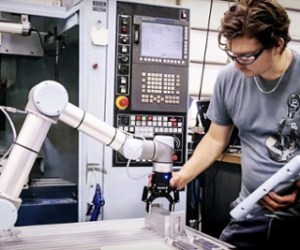This is the first in a series of articles about Collaborative Robots
Getting Started with Collaborative Robots? Part 1 - What can collaborative robots do?
Contributed by | Robotiq
In this chapter, we’ll explore the possibilities provided by collaborative robots. This will be useful when we start looking around the factory floor for places with automation potential.
Although collaborative robots are a new technology, this does not mean that they are necessarily complex. In fact, it’s the complete opposite. While traditional robots have evolved to satisfy the need for high volume industries, collaborative robots have been designed for the challenges of high mix manufacturing found in all SMEs.

Just like traditional robots, collaborative robots can:
- Move parts around
- Follow a path to perform a process
- Work autonomously for extended periods of time, increasing productivity and quality
But unlike traditional industrial robots, collaborative robots:
- Are simple and fast to program by non-experts. Think - half a day of onsite training, compared to 2-days of offsite classes for industrial robots.
- Have a small footprint. Most applications don't require fencing.
- Are simple to integrate for the simple tasks. These are the tasks you should start with.
- Can be repurposed easily for new tasks.
The bottom line is that with collaborative robots it is possible to do the same tasks that you would do with industrial robots, but with a smaller, less risky investment and a greater flexibility.
Here are a couple of examples of what can be done using collaborative robots:
• Machine Tending: Placing a part in a machine for processing. The robot can load and unload the part, hence freeing the operator from this redundant task.
• Pick-and-place: Moving a part from the output of one process to the input of the next. For example, grabbing parts from a bin and ordering them on a tray. Here again, this is a non-value added task that frees the operator.
• Lightweight applications: Most applications that can be done by a human without requiring dexterity can be done by a collaborative robot. A great application for full human-robot collaboration is where the robot is moving the part and the operator is using his/her dexterity to assemble the part.
However, before going hog wild and buying just any robot, you need to know which applications are best suited for automation.
Going further: Learn more about collaborative robots, download the eBook here.
ROBOTIQ MAKES TOOLS FOR AGILE AUTOMATION
 Robotiq’s mission is to free human hands from tedious tasks so companies and workers can focus where they truly create value.
Robotiq’s mission is to free human hands from tedious tasks so companies and workers can focus where they truly create value.
Our grippers and sensors enhance robot application flexibility and integration simplicity.
Our products are sold and supported in more than 30 countries, through a network of highly capable channel partners.
The content & opinions in this article are the author’s and do not necessarily represent the views of RoboticsTomorrow
Featured Product

